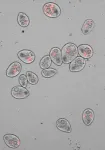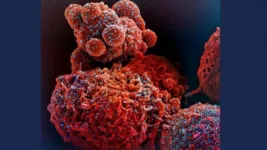(Press-News.org) Opportunistic pathogens are typically benign microbes that can sometimes cause infections in individuals with weakened immune systems or when they gain access to sterile areas of the body. Unlike obligate pathogens, opportunistic pathogens do not depend on host infection or transmission for survival, making it difficult to determine the factors driving the evolution of virulence in these microbes. Nevertheless, given their potential to cause severe infections in immunocompromised patients and the increasing prevalence of multidrug resistance in these species, understanding the factors that drive their virulence is crucial. While researchers have hypothesized that predation of bacteria by protists—larger eukaryotic microbes—might increase the virulence of opportunistic pathogens, there has been conflicting evidence from evolution experiments. In a new study published in Genome Biology and Evolution, researchers from North Carolina State University showed that the presence of the protist predator Tetrahymena thermophila increased the virulence of the opportunistic pathogen Serratia marcescens. These findings suggest that predation plays a dual role in microbial evolution, influencing both the survival strategies and pathogenic potential of bacterial prey.
The study, undertaken by research associate Heather Hopkins, graduate student Christian Lopezguerra, postdoctoral researcher Meng-Jia Lau, and led by assistant professor Kasie Raymann, involved the experimental evolution of S. marcescens, a widespread bacterium known to produce a red pigment that has been linked to both the pink film lining bathroom tiles and cases of “miraculous” bleeding statues and communion wafers. S. marcescens can also cause opportunistic infections in a wide variety of plant and animal hosts. In humans, S. marcescens commonly occurs in the gastrointestinal tract, where it is generally considered harmless, but it is also known to cause dangerous nosocomial infections in the respiratory and urinary tracts. “The ability of S. marcescens to inhabit so many diverse hosts and environments makes it a perfect model for studying bacterial adaptation and the evolution of virulence,” notes Raymann. “I started working on S. marcescens as a postdoc because it is an opportunistic pathogen of honey bees, but I quickly became intrigued by its broad host range and ability to thrive everywhere, including my bathroom.”
The researchers evolved S. marcescens KZ19, a strain known to cause opportunistic infections in honey bees, for 60 days. Six lines were grown in the presence of the ciliate T. thermophila, a generalist protist predator, and six lines were grown without any protists. They then sequenced the S. marcescens lines, as well as individual isolates from each line, and characterized both the genotypic and phenotypic changes in the different populations.
Surprisingly, a large number of mutations occurred at the same site or in the same gene across multiple evolved lines. These parallel mutations occurred significantly more often than expected by chance, indicating positive selection in all evolved populations to adapt to their respective environments. “It was surprising to see the same mutations across replicates, and to be able to see it in such a small time frame was powerful,” said Hopkins. “This reflects how evolution is constantly shaping the world we live in, even if it's not obvious on a daily basis.”
Many of the parallel mutations occurred within a single protein–protein interaction network, affecting proteins in the BarA-UvrY two component regulatory system and the three core proteins of the Rcs phosphorelay system. The BarA-UvrY system is believed to regulate the production of toxins, quorum sensing, motility, and several metabolic functions, while the Rcs system regulates motility, capsule biosynthesis, biofilm formation, and virulence. According to the study’s authors, mutations in these genes are likely to have major impacts by altering the expression of multiple downstream genes.
Interestingly, there were some notable differences in the types of mutations that occurred in the lines exposed to T. thermophila compared to the lines evolved in the absence of a protist predator. Most strikingly, S. marcescens populations subject to predation exhibited several mutations in genes involved in forming biofilms, assemblages of bacteria that adhere tightly to surfaces and are enclosed in an extracellular matrix. While biofilm formation is a natural defense mechanism against predation, biofilms are also heavily associated with virulence and antimicrobial drug resistance.
To determine the effects of the observed mutations, the researchers assessed the growth, biofilm formation, predation resistance, and virulence of isolates from each evolved population. As expected, S. marcescens populations exposed to T. thermophila exhibited stronger predation resistance and biofilm formation than the predator-free populations. Remarkably, the predator-exposed lines also showed greater virulence, resulting in higher mortality of honey bees when the bees were fed the bacteria. In fact, there was a strong correlation between predation resistance and virulence in these lines, suggesting that predation can indirectly select for or maintain virulence in opportunistic pathogens.
While these results point to a complex interplay between predator-prey interactions and the evolution of virulence in opportunistic pathogens, this study is only a small piece of the puzzle according to Raymann, whose overall goal is to investigate how various environmental pressures impact the evolution of opportunistic pathogens. Investigations involving longer evolutionary experiments and different opportunistic bacteria are likely to further expand our view of the forces driving the evolution and virulence of opportunistic pathogens. Conducting such experiments is not without its challenges however. According to Raymann and Hopkins, potential obstacles include difficulties in linking specific mutations with their functional roles and accounting for the effects of abiotic and biotic factors present in the natural environment. Nevertheless, such studies are necessary to provide a better understanding of opportunistic pathogens and to help guide the development of more effective treatment strategies for combating bacterial infections.
END
Predation drives opportunistic bacteria to become more virulent
2024-08-20
ELSE PRESS RELEASES FROM THIS DATE:
Renewable energy policies provide benefits across state lines
2024-08-20
While the U.S. federal government has clean energy targets, they are not binding. Most economically developed countries have mandatory policies designed to bolster renewable electricity production. Because the U.S. lacks an enforceable federal mandate for renewable electricity, individual states are left to develop their own regulations.
Marilyn Brown, Regents’ and Brook Byers Professor of Sustainable Systems in Georgia Tech’s School of Public Policy; Shan Zhou, an assistant professor at Purdue University and Georgia Tech Ph.D. alumna; and Barry Solomon, a professor emeritus of environmental policy at Michigan Technological University, investigated ...
Be in the know! Press conference schedule for ESC Congress 2024 released!
2024-08-20
Sophia Antipolis, 20 August 2024: It’s not long before the global cardiology community converges in London for the European Society of Cardiology (ESC)’s annual gathering, unveiling the latest practice-changing science.
The ESC Press Conference Schedule is now available, detailing the nine press conferences that will take place from Thursday 29 August to Sunday 1 September, and can be accessed in person or online. Accredited journalists will also be able to access embargoed press materials in the digital press area from Thursday 22 August.
Join triallists and ESC spokespersons for eight press conferences on the Hot ...
To subvert immune response, COVID virus stimulates production of proteins without protective function
2024-08-20
To evade the human host’s immune response, SARS-CoV-2, the coronavirus that causes COVID-19, uses the machinery of defense cells to induce the expression of unproductive isoforms of key antiviral genes – variant forms of genes that result from disrupted splicing or transcription processes and do not code for functional (protective) proteins. This is a key finding of a study conducted by researchers at the Albert Einstein Jewish Brazilian Hospital (HIAE), the University of São Paulo (USP) and the ...
UC Irvine-led team finds that compound in rosemary extract can reduce cocaine sensitivity
2024-08-20
Irvine, Calif., Aug. 20, 2024 — A team of researchers led by the University of California, Irvine has discovered that an antioxidant found in rosemary extract can reduce volitional intakes of cocaine by moderating the brain’s reward response, offering a new therapeutic target for treating addiction.
The study, recently published online in the journal Neuron, describes team members’ focus on a region of the brain called the globus pallidus externus, which acts as a gatekeeper that regulates how we react to cocaine. ...
Purdue researchers receive additional $95K to develop arthritis treatments, drought-resistant soybeans
2024-08-20
WEST LAFAYETTE, Ind. — Researchers in Purdue University’s colleges of Agriculture and Science have received an additional $95,000 from the Trask Innovation Fund to develop patent-pending drought-resistant soybean plants and novel arthritis treatments.
The fund is managed by the Purdue Innovates Incubator, which provides programming for the Purdue University community to ideate, refine and support their solutions. Funding recipients can receive up to $50,000 for their initial project; ...
Social responsibility audits can bias financial ones
2024-08-20
AUSTIN, Texas — During the past decade, auditors have found a booming new business: reviewing reports on companies’ environmental, social, and governance (ESG) activities. ESG reporting among S&P 500 companies grew 80% from 2010 to 2020, with nearly half the companies hiring auditors to give seals of approval.
But while ESG reporting brings new opportunities to auditors, it can also bring new headaches, according to a new study from Texas McCombs. Test subjects who engaged auditors to review their ESG reports often pressured them to be more lenient on their financial reports — and auditors ...
Modic changes linked to microbial differences in lumbar spine
2024-08-20
August 20, 2024 — Among patients undergoing lumbar spinal fusion, the presence of Modic changes is associated with differences in microbial diversity and metabolites in the lumbar cartilaginous endplates (LCEPs), reports a study in The Journal of Bone & Joint Surgery. The journal is published in the Lippincott portfolio by Wolters Kluwer.
"These findings suggest that changes in the microbiota may disrupt unsaturated fatty acid metabolism within the LCEP microenvironment, potentially influencing the onset and progression of Modic changes [MCs]," according to the new research ...
Atul Malhotra, M.D., receives prestigious lifetime achievement award
2024-08-20
Atul Malhotra, MD, Peter C. Farrell Presidential Endowed Chair in Pulmonary Medicine at University of California San Diego School of Medicine and pulmonologist at UC San Diego Health, has been named recipient of the 2024 Sleep and Respiratory Neurobiology Lifetime Achievement Award by the American Thoracic Society.
The award is given annually to honor the career of an individual who has made outstanding contributions to the field of sleep or respiratory neurobiology in terms of both scientific and scholarly advances, as well as in mentoring, teaching and advocacy to advance public health.
Recipients are recognized for achievement in scholarship over the course of an entire ...
Brigham researchers use AI tools to uncover connections between radiotherapy for lung cancer and heart complications
2024-08-20
Researchers from Brigham and Women’s Hospital, a founding member of the Mass General Brigham healthcare system, have used artificial intelligence tools to accelerate the understanding of the risk of specific cardiac arrhythmias when various parts of the heart are exposed to different thresholds of radiation as part of a treatment plan for lung cancer. Their results are published in JACC: CardioOncology.
“Radiation exposure to the heart during lung cancer treatment can have very serious and immediate effects on a patient’s cardiovascular ...
New view of North Star reveals spotted surface
2024-08-20
ATLANTA — Researchers using Georgia State University’s Center for High Angular Resolution Astronomy (CHARA) Array have identified new details about the size and appearance of the North Star, also known as Polaris. The new research is published in The Astrophysical Journal.
Earth’s North Pole points to a direction in space marked by the North Star. Polaris is both a navigation aid and a remarkable star in its own right. It is the brightest member of a triple-star system and is a pulsating variable star. Polaris gets brighter and fainter periodically as the star’s diameter ...





